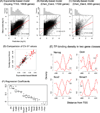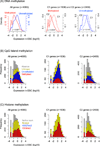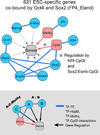A regression analysis of gene expression in ES cells reveals two gene classes that are significantly different in epigenetic patterns
- PMID: 21342583
- PMCID: PMC3044308
- DOI: 10.1186/1471-2105-12-S1-S50
A regression analysis of gene expression in ES cells reveals two gene classes that are significantly different in epigenetic patterns
Abstract
Background: To understand the gene regulatory system that governs the self-renewal and pluripotency of embryonic stem cells (ESCs) is an important step for promoting regenerative medicine. In it, the role of several core transcription factors (TFs), such as Oct4, Sox2 and Nanog, has been intensively investigated, details of their involvement in the genome-wide gene regulation are still not well clarified.
Methods: We constructed a predictive model of genome-wide gene expression in mouse ESCs from publicly available ChIP-seq data of 12 core TFs. The tag sequences were remapped on the genome by various alignment tools. Then, the binding density of each TF is calculated from the genome-wide bona fide TF binding sites. The TF-binding data was combined with the data of several epigenetic states (DNA methylation, several histone modifications, and CpG island) of promoter regions. These data as well as the ordinary peak intensity data were used as predictors of a simple linear regression model that predicts absolute gene expression. We also developed a pipeline for analyzing the effects of predictors and their interactions.
Results: Through our analysis, we identified two classes of genes that are either well explained or inefficiently explained by our model. The latter class seems to be genes that are not directly regulated by the core TFs. The regulatory regions of these gene classes show apparently distinct patterns of DNA methylation, histone modifications, existence of CpG islands, and gene ontology terms, suggesting the relative importance of epigenetic effects. Furthermore, we identified statistically significant TF interactions correlated with the epigenetic modification patterns.
Conclusions: Here, we proposed an improved prediction method in explaining the ESC-specific gene expression. Our study implies that the majority of genes are more or less directly regulated by the core TFs. In addition, our result is consistent with the general idea of relative importance of epigenetic effects in ESCs.
Figures




Similar articles
-
Signed weighted gene co-expression network analysis of transcriptional regulation in murine embryonic stem cells.BMC Genomics. 2009 Jul 20;10:327. doi: 10.1186/1471-2164-10-327. BMC Genomics. 2009. PMID: 19619308 Free PMC article.
-
Synthetic and genomic regulatory elements reveal aspects of cis-regulatory grammar in mouse embryonic stem cells.Elife. 2020 Feb 11;9:e41279. doi: 10.7554/eLife.41279. Elife. 2020. PMID: 32043966 Free PMC article.
-
Differential recruitment of methyl CpG-binding domain factors and DNA methyltransferases by the orphan receptor germ cell nuclear factor initiates the repression and silencing of Oct4.Stem Cells. 2011 Jul;29(7):1041-51. doi: 10.1002/stem.652. Stem Cells. 2011. PMID: 21608077 Free PMC article.
-
Returning to the stem state: epigenetics of recapitulating pre-differentiation chromatin structure.Bioessays. 2010 Sep;32(9):791-9. doi: 10.1002/bies.201000033. Bioessays. 2010. PMID: 20652894 Review.
-
[The alchemy--epigenetic regulation of pluripotency].Postepy Biochem. 2013;59(2):144-56. Postepy Biochem. 2013. PMID: 24044279 Review. Polish.
Cited by
-
Bayesian integrative analysis of epigenomic and transcriptomic data identifies Alzheimer's disease candidate genes and networks.PLoS Comput Biol. 2020 Apr 7;16(4):e1007771. doi: 10.1371/journal.pcbi.1007771. eCollection 2020 Apr. PLoS Comput Biol. 2020. PMID: 32255787 Free PMC article.
-
Understanding gene regulatory mechanisms by integrating ChIP-seq and RNA-seq data: statistical solutions to biological problems.Front Cell Dev Biol. 2014 Sep 17;2:51. doi: 10.3389/fcell.2014.00051. eCollection 2014. Front Cell Dev Biol. 2014. PMID: 25364758 Free PMC article.
-
Bayesian mixture regression analysis for regulation of Pluripotency in ES cells.BMC Bioinformatics. 2020 Jan 2;21(1):3. doi: 10.1186/s12859-019-3331-2. BMC Bioinformatics. 2020. PMID: 31898480 Free PMC article.
-
The DNA methylation signature of smoking: an archetype for the identification of biomarkers for behavioral illness.Nebr Symp Motiv. 2014;61:109-27. doi: 10.1007/978-1-4939-0653-6_6. Nebr Symp Motiv. 2014. PMID: 25306781 Free PMC article. Review.
-
A cross-platform genome-wide comparison of the relationship of promoter DNA methylation to gene expression.Front Genet. 2012 Feb 6;3:12. doi: 10.3389/fgene.2012.00012. eCollection 2012. Front Genet. 2012. PMID: 22363339 Free PMC article.
References
Publication types
MeSH terms
Substances
LinkOut - more resources
Full Text Sources
Research Materials
Miscellaneous

